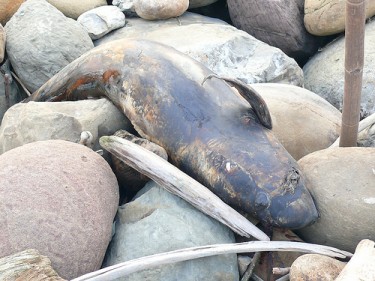More than a dozen Finless Porpoise corpses have been found in Dongting Lake [1] in Hubei and Hunan provinces since March 2012. Chinese micro-bloggers are keeping each other updated on the situation while trying to determine the reasons for the deaths of this endangered species, as the government is yet to confirm the death toll and put forward a rescue plan.
The Finless Porpoise [2] is one of the most endangered species in China. Information spreading online said [3] [zh] that there are fewer than 84 remaining in Dongting Lake. The large scale death of this endangered species should be national news, yet the state controlled media outlets have been downplaying this news and as yet no government authority is actively responding to the problem.
Magazine reporter Yang Jiang has been a consistent source of information regarding this issue, reporting [5] [zh] in microblogging website Sina Weibo [6]:
刚连线湖南岳阳江豚保护协会会长,证实,从3月3日至今,洞庭湖已发现的死亡江豚为12头,非网络流传的17头,但该协会不排除有更多尚未发现的江豚尸体,原因初步判断为环境污染所致…,另,此次至少7头是母江豚,照此速度,洞庭湖江豚一年内灭绝也不是没有可能。
Blogger Yongaiqiqi has gathered information from various sources, including newspapers and online reports, and found that there were more than thirteen reports on the discovery of Finless Porpoise bodies in 2012 and that only one report came from state controlled media [8] [zh].
现在我要问:对洞庭湖已经发生的如此严重的江豚集中死亡恶性事件,当地政府为什么至今没有发布信息向社会公开?是不知情?还是有意隐瞒真相?呼吁当地政府尽快作出负责任的回应,澄清事实。
Blogger “Subject of the Empire” examined [9] [zh] the problem in detail and found that aside from the underlying ecological reasons, the Finless Porpoise might have been poisoned by snail fever prevention treatment:
2008年记录死亡江豚20头,2009年为19头,2010年为12头。连续3年,江豚死亡都是两位数。要知道江豚种群总数已经比大熊猫还少,每年两位数的死亡速度实在太高了!太快了!太危险了!刚刚过去的2011年,记录死亡20头,然而进入2012年仅仅只是东洞庭湖一个栖息地,3月份以来40天内就死亡了12头,这还只是被渔民发现的江豚尸体,考虑到江豚一般都是以父母子女一家为活动习惯的规律分析,实际死亡情况更加严重,按照中科院豚类专家王丁先生们的研究判断,这次可能已经有30多头江豚已经死亡,这难道还不足以引起相关政府主管部门和研究机构的高度重视吗。
Regarding the death toll of the Finless Porpoise, in 2008, 2009 and 2010, there were 20, 19 and 12 deaths respectively. In three consecutive years, the death tolls were in double figures. We have to be aware of the fact that the total number of Finless Porpoises in China is less than the number of pandas. This death rate is already too high and too dangerous. In 2011, the recorded death toll reached 20. In 2012, in Dongting alone and in less than 40 days, 12 corpses have been found, with this figure only including those corpses discovered by fishermen. Since Finless Porpoises live together in family groups, the situation is probably even more serious.According to the Finless Porpoise expert Wang Ding from the Chinese Academy of Sciences, the death toll may have reached 30. This is an alarming figure that the government and research organizations must pay attention to.
洞庭湖的生态危机其实已经早就成了众所周知的事实,江豚为什么濒临灭绝,这是与整个洞庭湖生态链遭到严重破坏、是与多年来围湖造田、滥捕滥捞、竭泽而渔分不开的,更是与渔政部门长期行政不作为、监管不力甚至为了经济利益纵容滥捕滥捞分不开的,加之洞庭湖水位随着三峡大坝蓄水后大幅下降,阻断了千百万年来年复一年的洪水泛滥,大面积的湿地长期裸露在外,再有就是大量挖砂船活动、大量捕捞螺类底层物种致使湖区食物链、生态链断裂…
江豚的意外死亡,其实也不意外,在人类与江豚争夺食物也就是鱼类水产的时候,江豚甚至自身都处于被人类捕杀的境地,何况其食物链已经接近断裂;洞庭湖鱼类资源作为江豚的食物来源,已经从10多年前还剩下120多种急骤下降到目前仅存10多种…
我注意到今天的湖南经视新闻在报导本次江豚密集死亡事件的新闻中,采访了岳阳渔政部门的相关领导,他以自己的经验猜测可能是由于近期岳阳县出于血防需要在洞庭湖区投放杀钉螺药剂有关,可能是江豚误食了被灭螺毒死的鱼有关,我认为这当然是最直接的原因之一,但我就纳闷了,这种后果其实并非今天才出现,而是早就发生过,为什么就没有引起相关部门重视并在工作上加以改进呢?我查了一下资料, 洞庭湖江豚多年来饱尝命丧之虞就有类似直接的人为原因,2004年,岳阳为迎接全国血吸虫病防治工作会议的召开,在洞庭湖区投放了约5000吨杀钉螺药剂,曾酿下一个月内毒死6头江豚的惨剧。
This post was sub-edited by Jane Ellis [12].
